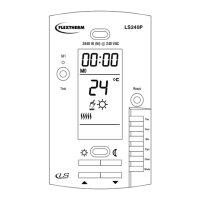
Do you have a question about the Flextherm LS240P and is the answer not in the manual?
| Display | LCD |
|---|---|
| Protection Class | IP20 |
| Application | Floor Heating |
| Accuracy | ±0.5°C |
| Mounting | Wall Mount |
Explanation of the three selection switches for temperature, time, and early start function.
Instructions on how to adjust the time and day using the DAY, HOUR, and MIN buttons.
Steps to select and record the desired comfort setpoint temperature.
Steps to select and record the desired economy setpoint temperature.
Guide on how to test the Ground Fault Circuit Interrupter for proper function.
How to select between AUTO and MAN operating modes using the MODE button.
Instructions for connecting wires and physically mounting the thermostat.
Emphasizes the need to follow local electrical codes for all connections.
Crucial warning about using specific connectors for aluminum wiring.
Guidance on connecting the temperature sensor wire and its placement.
Describes the display behavior and indicators upon initial power application.
Detailed steps to test GFCI, what to do if it fails, and troubleshooting advice.
Overview of thermostat installation for electric heating systems and load limits.
Mandates installation compliance with national and local electrical codes.
Notes that the thermostat is intended for use with a heating system that has a circuit breaker.
Lists the components included with the LS240P thermostat package.
Critical safety instruction to turn off power before installation to prevent electric shock.
Explains the two operating modes: MANUAL and AUTOMATIC.
Details how to operate the thermostat in MANUAL mode for constant temperature.
Explains how to operate the thermostat in AUTOMATIC mode for programmed schedules.
Describes how the thermostat retains programming and time during power failures.
Explains the Early Start feature that calculates optimal heating start times.
Steps to set the current time and day on the thermostat.
Instructions for setting desired temperatures for Comfort, Economy, and Vacation modes.
Details on how to create custom heating schedules with 4 setting changes per day.
Illustrates programming a typical daily schedule for comfort and economy periods.
Specific instructions for modifying weekend schedules, including erasing programs.
How to temporarily override programmed settings or set a permanent vacation bypass.
Technical details including model, supply, load, power, GFCI class, and approvals.
Defines the display range, setting range, and default comfort/economy settings.
Details the terms and conditions of the one-year limited warranty for the thermostat.
Outlines what is not covered by the warranty and liability limitations.
Instructions on how to return defective products to the retailer or installer.
